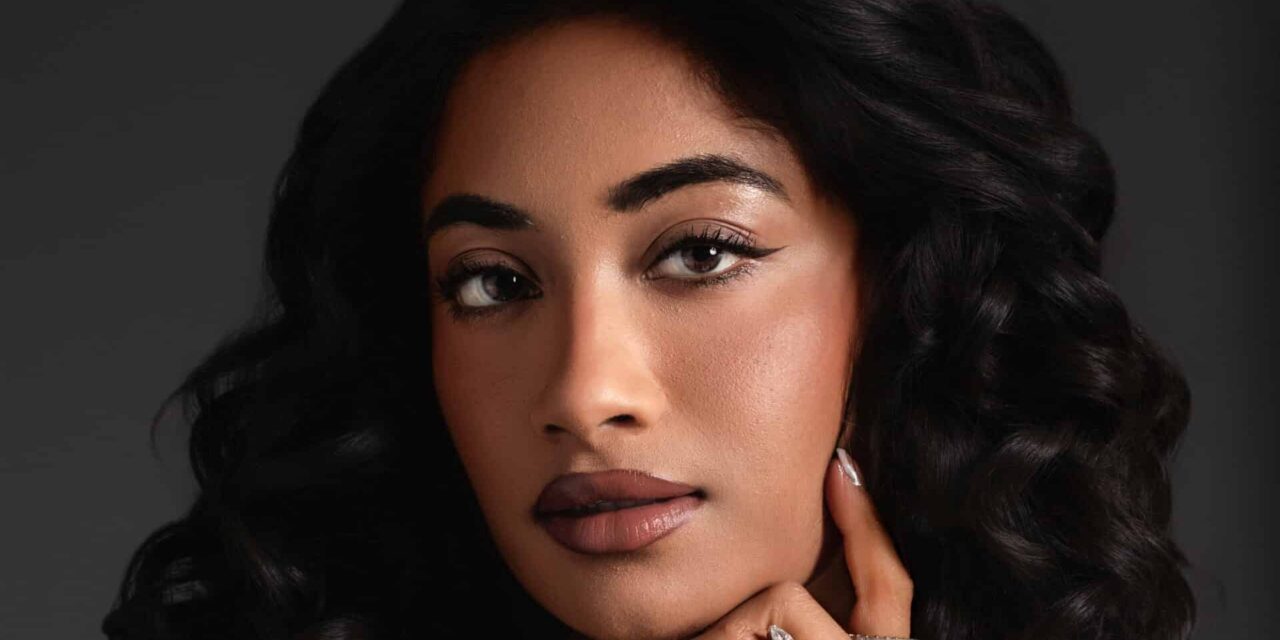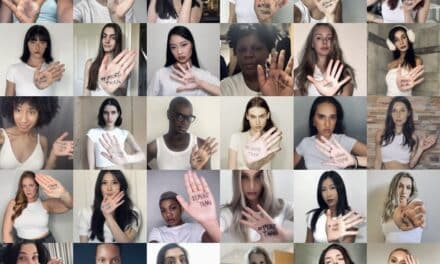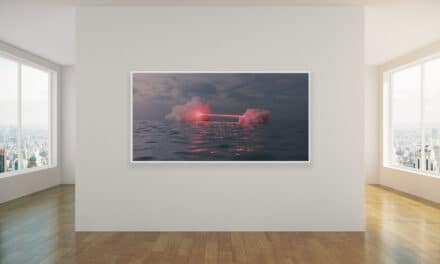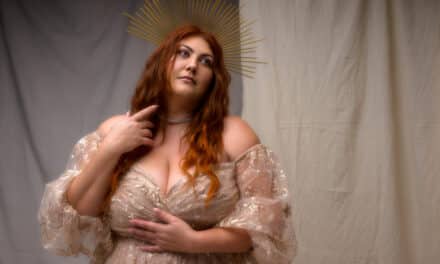Monica Ravichandran didn’t set out to become a beauty influencer. In fact, her journey started in a computer science lab at Cal Poly San Luis Obispo, where she was more likely to be debugging software than swatching lipsticks. But today, she stands at the forefront of a new, more inclusive era in beauty—as a content creator, educator, consultant, and the original force behind the viral TikTok trend #lipstickcolortheory trend.
Now, the first-generation Indian American is taking her love of beauty to the next level with the launch of her first red lipstick, created in collaboration with a soon-to-be-announced brand. But this isn’t just any lipstick—it’s a meticulously developed shade rooted in color theory and cultural memory, designed to work across warm, deeper skin tones that are often overlooked in mainstream product lines. It’s also a deeply personal project: the lipstick will debut just ahead of her August wedding, a three-day celebration blending her Indian heritage with her fiancé’s Irish roots.
“It’s inspired by my mom’s favorite lipstick color,” Monica shares. “I wanted a red that didn’t just ‘work’ on brown skin—I wanted one that celebrated it.”
Monica’s background in software engineering might seem like an unusual starting point for a beauty creator, but she credits that technical foundation with helping her stand out. She approaches makeup with the precision of a scientist, spending time in labs in Italy researching undertones and pigment formulation.
“Color theory isn’t just an art concept—it’s science,” she says. “And when I saw the gaps in inclusive shade ranges, I knew it wasn’t about lack of demand. It was a lack of understanding.”
That understanding, paired with her content-savvy communication style, has earned her a loyal following and the respect of top beauty brands. Monica has worked with major players like NYX Cosmetics, The Ordinary, Vaseline, and Rare Beauty, and has appeared on high-profile panels including SXSW, where she advocates for inclusive product development and education.
Monica’s breakout moment came with her creation of the #browngirlmakeup trend on TikTok, which gave visibility to South Asian beauty consumers and opened up new conversations about representation in makeup. Her content—equal parts tutorial, theory, and cultural commentary—educates audiences on how to find their undertones, make smarter product choices, and reject one-size-fits-all beauty narratives.
With over 900K YouTube subscribers, 700K TikTok followers, and nearly half a million followers on Instagram, Monica has built a community that transcends aesthetics. Her work is about ownership—of culture, identity, and self-expression.
“There’s power in feeling seen in a beauty aisle,” she says. “I want everyone—especially young people of color—to know that they don’t have to settle for ‘close enough.’ Their skin tone deserves precision, too.”
As Monica prepares to walk down the aisle later this summer, she’s also stepping into her next chapter as a creator-turned-product-developer. Her red lipstick launch isn’t just a wedding accessory—it’s a statement of values, of technical mastery, and of personal pride. It’s also a tribute to her mother and the generations of women whose beauty often went unacknowledged by mainstream brands.
“This lipstick is for them—and for every brown girl who was told red wasn’t her color. It always was.”
With her STEM-to-beauty pipeline, her unapologetic voice, and her commitment to making beauty smarter and more inclusive, Monica Ravichandran is proving that innovation doesn’t just belong in tech—it belongs on vanities, too.
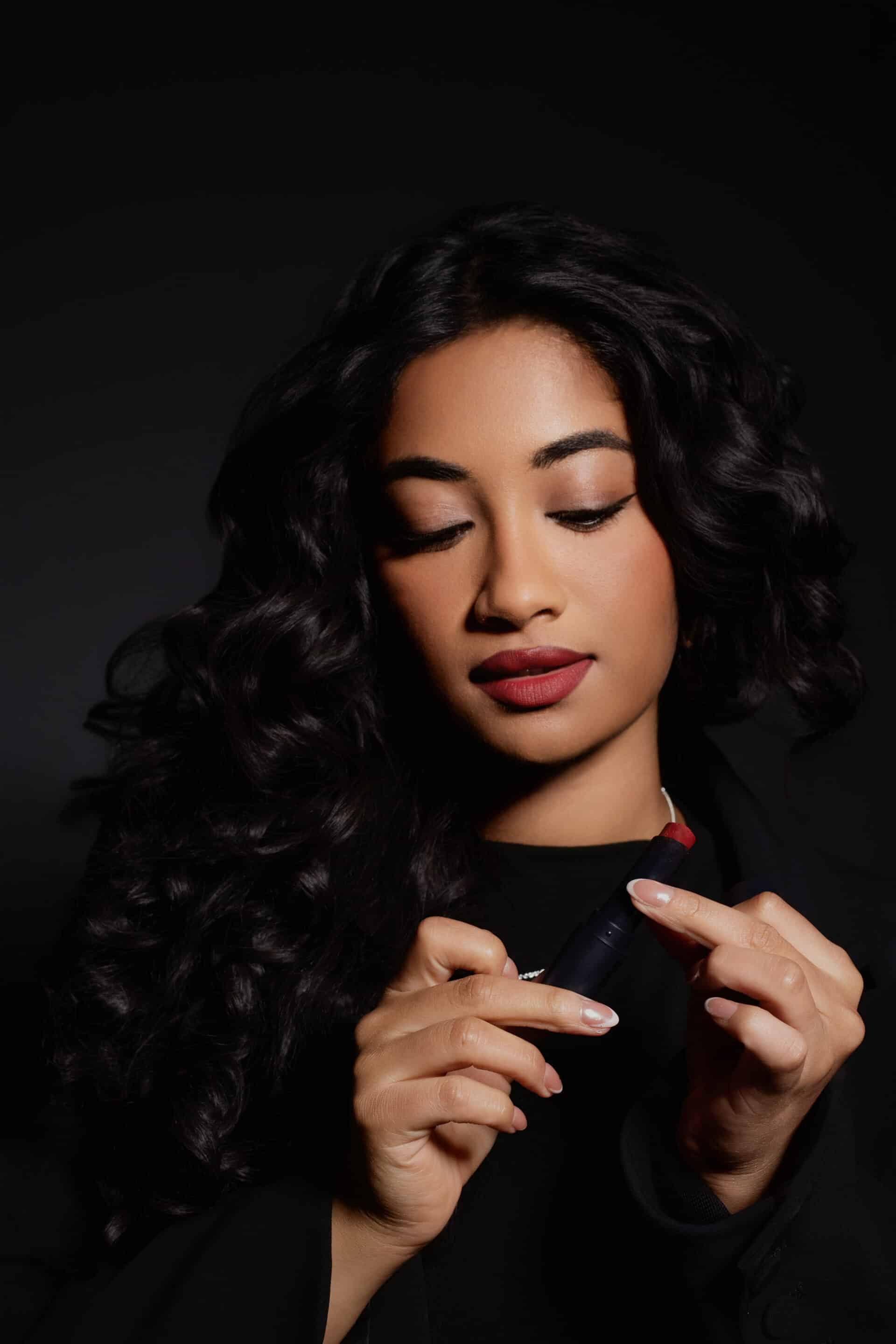
You’re known as the creator of the #browngirlmakeup trend—what inspired you to start this movement, and how have you seen it evolve since its inception?
I wouldn’t say #browngirlmakeup is really a trend. It was a movement that started by Youtubers a really long time ago, but around the time when I started posting on TikTok there were no brown girls posting this sort of content. My first viral videos were about graphic liner and editorial makeup looks, but the more I kept posting, the more in detail questions I kept getting from women of color asking for help with their makeup. After noticing the gap – primarily on TikTok – I felt I would be able to really serve a community and create purpose driven content when I rebranded into specifically helping brown girls with their beauty issues. I feel like its evolved now into something really community oriented, and the delivery of my message has changed over the years, but my fundamentals will always be the same – which is to empower brown girls to feel confident.
How has your background in computer science and experience as a software engineer informed your unique approach to the beauty industry?
A big part of my rebrand in 2021 was because I realized I could start using an SEO strategy with my content. 1 year into my software engineering job, I felt I could start reverse engineering content the same way I code, which is building from the bottom up. As a software engineer, you basically adopt a problem-solving mindset, so I started a “Brown girl problems” series where my hope was to solve each brown girl makeup problem, day by day. By using SEO optimized keywords, it also helps make my content searchable, so even though the content wouldn’t go immediately viral, now almost 40% of my content is found via search. I also have one of my employees run a comment sentiment AI analysis report monthly to generate new ideas for the next month based off of community sentiment and questions. Additionally, I feel like my engineering brain has led me to focus my content on color theory, because most brown girls face issues due to a lack of understanding of relative contrast and color theory, at the same time as shades not being inclusive enough
You’ve spent time in Italian labs analyzing undertones to create more inclusive shades—what was one of the most surprising discoveries you made during that process?
The most surprising discovery for me was how most brands just benchmark the same foundations over and over again, and their lack of the use of green & blue pigment. A big struggle my community faces is a lot of the undertones in the deeper ranges run really ashy or orange. And now I realize it’s because 1. Brands are just copying other brands’ foundation shades and 2. Very few labs use the blue/green pigments to cut the orange in the foundation – presumably because it increases the cost of goods.
You’re launching your own red lipstick soon. Can you walk us through the process of creating “the perfect red,” and how your personal story influenced the final product?
My mom wore red lipstick her whole life – to work, to the grocery store, to her wedding, even when she would pick us up from school. For her, it was like a nude lip, but it always made her feel powerful. Back then I didn’t understand color theory, and because my mom and I have very different skin tones, I couldn’t understand why her favorite shade of red lipstick – MAC Russian Red – never looked good on me. Red lipstick is a huge part of my culture, so naturally I really wanted to wear a red lip for my wedding in August to continue the tradition, which inspired this series on my socials of finding my “perfect red lip”. This series made me realize how many other girls were struggling to find a red lip too and how every brand was also just benchmarking Mac Ruby Woo or Mac Russian Red again. So, MOB beauty saw this search and invited me to their lab to make my perfect red lip. The red lip I made isn’t benchmarked off another red lip, but rather benchmarked off myself and how it looks on me. I wanted a red lip like my mom has that I can wear every day and to my wedding. The craziest part of this process is that Vic Casal, the founder of MOB Beauty, just so happened to be the Head Chemist at MAC Cosmetics years ago, and actually helped create the shade MAC Russian Red! So the fact that he was able to make my perfect shade for me with his new brand, feels so special.
You’re preparing for a three-day Indian-Irish wedding—how has planning such a culturally rich celebration impacted your perspective on beauty and identity?
I think it’s actually made me realize how appreciative I am of both cultures. Both are beautiful in their own ways, and I now get to wear 5 different dresses and coordinate different makeup looks to match, which is so fun for me!
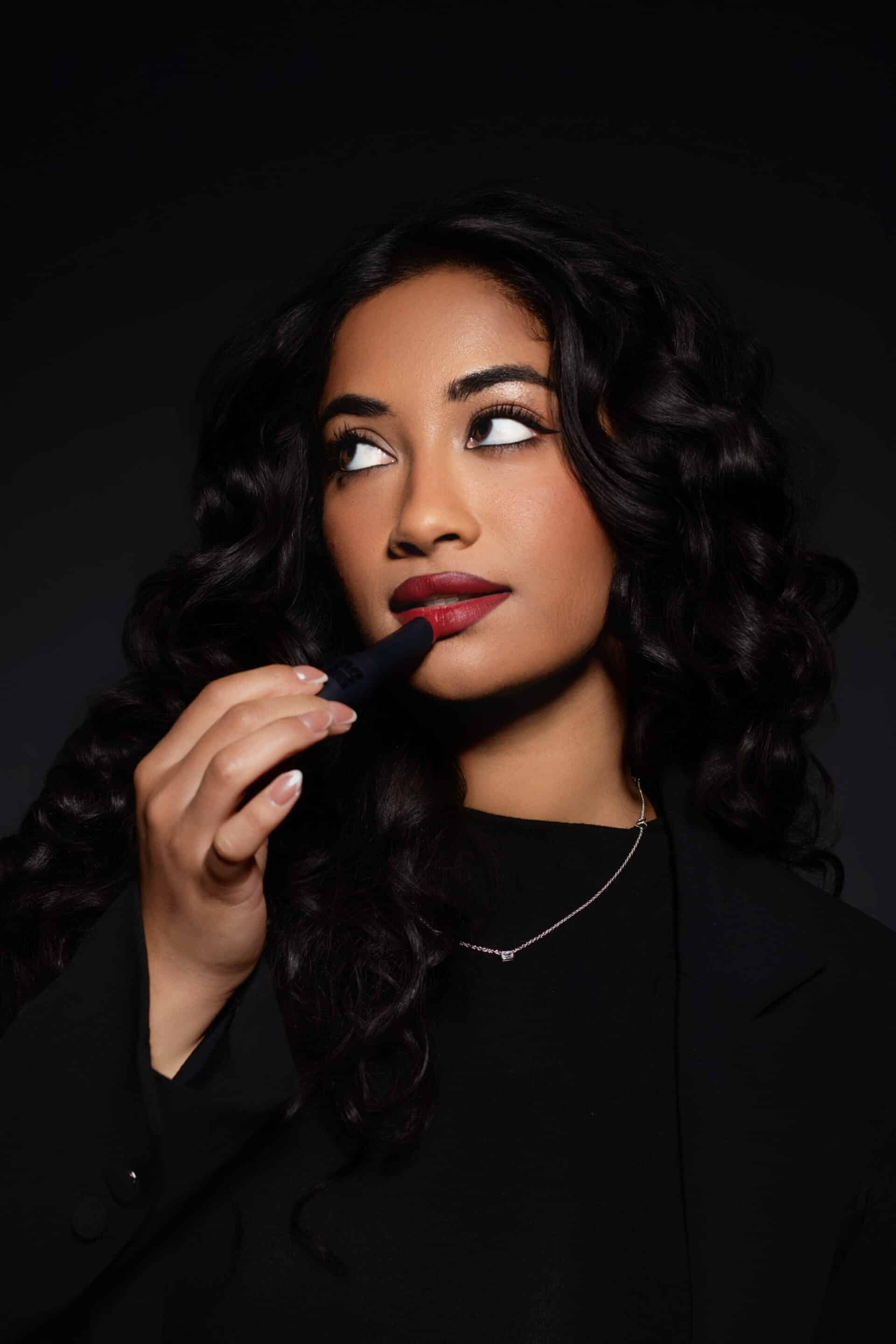
Many see color theory as an art—how do you balance the creative and scientific sides when it comes to makeup formulation and education?
Color theory is an art but it’s also science. I think color theory is a great guideline to figure out why something is and isn’t working for you, but at the end of the day we shouldn’t let color theory stifle creative freedom. Life is too short to not wear your favorite colors, no matter what color theory says.
You’ve worked with some of the biggest names in the beauty world—what have you learned from collaborating with these top-tier brands, and what advice would you give to creators hoping to do the same?
Something I’ve learned is to always stick to your values. Brands and collaborations will come and go but your values and what you bring to your community will make sure you have a long-term career. And this is also my biggest advice for creators too – standing for everything, means you stand for nothing. Figure out what YOU are passionate about and never let go of your values, no matter how big the paycheck is.
As a Gen-Z content creator with a STEM background, how do you see your generation shaping the future of beauty and inclusivity?
I think Gen-Z cares about inclusivity more than ANY other generation. I think people are finally realizing that beauty is more than just a business – it’s also a feeling. It’s not just fact that you can go to school and bond with your friends over loving the same makeup product, even if you wear different shades, but it’s also the fact that there ARE different shades. I was a water polo player for most of my life growing up, so I grew up with a deeper skin tone than my friends, and I could barely ever find a shade for me at the drugstore. And it makes me so happy now that brands are realizing how important it is for future generations to see themselves represented on the shelves, and thus feel included.

What are some common misconceptions brands still have about inclusive shade ranges, and how do you work to challenge those in your consulting work?
I feel like the biggest misconception is in the undertones. I’m so glad brands are finally expanding on the shade inclusivity, but I don’t care if they make darker shades if the undertones are HORRIBLE. Additionally, as someone who has olive skin, olive foundations are SO rare, and hard to find. I’m hoping to further consult and be able to educate on undertones in the deeper shade ranges because a lot of foundation launches are just extending the shades (in hopes of not being called out online) but the undertones are still so bad.
What’s next for you after the lipstick launch and your wedding—are there more product lines or educational initiatives we should be watching for?
My goal is to continue expanding upon consulting opportunities, learn from more chemists and product developers, build my beauty network, and hopefully work on a business plan for my brand one day.

